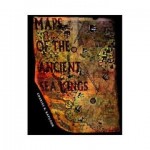 In 2013 in the summer month of December (for the Southern Hemisphere), an Australian climate-change professor led a group of scientists and tourists to retrace a 1912 research expedition in Antarctica. One of goals of the trip was to gauge how a warming climate has affected the continent. However, two weeks into the trip their ship was firmly trapped in ice. Two more ice breaker vessels were sent to rescue the ship, and one of them also became trapped in the ice. Unable to break the thick layers of ice, the passengers were finally rescued by a helicopter, leaving only the crew to remain and hope the ice would soon melt enough to break free.
In 2013 in the summer month of December (for the Southern Hemisphere), an Australian climate-change professor led a group of scientists and tourists to retrace a 1912 research expedition in Antarctica. One of goals of the trip was to gauge how a warming climate has affected the continent. However, two weeks into the trip their ship was firmly trapped in ice. Two more ice breaker vessels were sent to rescue the ship, and one of them also became trapped in the ice. Unable to break the thick layers of ice, the passengers were finally rescued by a helicopter, leaving only the crew to remain and hope the ice would soon melt enough to break free.
Meanwhile in the United States, record cold temperatures covered more than half of the country. For the past twelve years, average world temperatures have remained unchanged. There has been a vastly smaller warming trend than what was predicted by the U.N.’s Intergovernmental Panel on Climate Change (IPCC) about 24 years ago. Since the late 1800s, the rise in average global temperatures has been a little over one-half degree Celsius.
So, have the world’s climate researchers had second thoughts about a global warming trend? Well, yes and no.
There are basically two groups of climate researchers and they have come to very different conclusions, even as they study the same data. Both groups acknowledge that CO2 and other greenhouse gases have the potential to warm the earth’s average temperature. Both groups acknowledge that there is an increase in the amount of CO2 and other greenhouse gases that are going into the atmosphere.
However, one group staunchly believes that as a result of an increase in greenhouse gases, the temperature of thee earth will continue to warm, the polar ice caps will begin to melt, sea levels will rise, coastal cities will flood, and eventually the world’s health and economic structures will be significantly disrupted. This group even found a way to blame the colder than normal temperatures of December and January on disruptions caused by warming temperatures.
The other group finds the threat of global warming to be greatly exaggerated. They have concluded that the slight increase in average global temperatures will be absorbed by the earth’s natural systems with minimal and non-catastrophic effects on the earth. They consider that earthquakes, volcanoes, and other natural events play a role in climate changes.
The first group believes that the cause of the warming trend is anthropogenic or human-induced. The solution, they believe, will be found in international treaties, stricter laws and regulations, and carbon exchanges. The Kyoto Treaty from several years ago was an attempt to get the world’s nations to agree to a series of dramatic restrictions on industries and sources of energy. One of the problems with Kyoto is that all nations are not willing to accept the restrictions. China, in particular, has greatly increased greenhouse gas emissions during the past five years. Even if the U.S. agreed to the restrictions, China and other nations would offset our efforts.
It would seem that the two groups of scientists would find a way to resolve conflicts regarding how they interpret the evidence in a professional manner. For decades, scientists have submitted their research to open debates and professional critiques from other scientists in order to filter out weak explanations and reinforce the more valid ones.
However, when it comes to certain environmental issues, there is a decidedly non-professional aspect. Instead of just presenting scientific research that is subject to open debate and critical reviews, there is often an attempt to malign competing researchers. Competitors are often accused of lying, falsifying data, and participating in other unprofessional actions. One large publication blames Fox News and talk radio with inciting “climate change deniers” with emotionally charged arguments. A number of publications refuse to print articles written by those they call “climate change deniers.” Large federal research grants, pressure from certain groups of scientists, and support from certain politicians seem to be more of an incentive than an honest search for what is really true.
I am referring to this situation because there is a new push in education to convince young children of the dangers of climate change, so they will be prepared to take decisive action on environmental issues as adults. The proposed Next Generation Science Standards are designed to fit with the math and language Common Core standards.
This program approaches climate change and environmental issues, as well as evolution, from the position that debate and challenging scientific evidence are not necessary. The claim is made that all reputable scientists agree that evolution is true and that climate change is a major problem that needs to be addressed in order to prevent catastrophic events in the future.
There is a decided shift in the new science standards to include more information about both evolution and environmental issues. In the life science category, evolution and the environment make up about 50% of the standards. Both topics will be taught without scientific challenges. Furthermore, these topics will begin in the earliest grades and continue in a progressive way through high school.
I expect that if children are taught from K-12 that humans are causing great damage to the earth with factories and machines and burning fuels, they will be ready as young adults to accept international treaties and laws that will restrict many of our freedoms. This is especially true for the youngest students. After all, many children believe in Santa Clause, the tooth fairy, and the Easter bunny, so believing whatever their teacher tells them is not a great stretch.
Parents, teachers, and school officials have a huge responsibility to be diligent and informed about what children are being taught. Taking care of the environment has been, and continues to be, a very important topic for students to learn. Recycling, maintaining clean water supplies, keeping the air free from pollutants, and protecting our food supplies are a few of the environmental issues about which students need to stay informed.
My warning is directed toward controversial scientific topics where no debate is allowed, claiming that all reputable scientists agree that one side is true. Since Next Generation Science Standards have yet to be adopted in most states, parents, teachers, school officials, as well as elected legislators need to take sufficient time to adopt a balanced science curriculum that doesn’t promote an agenda.




 In 2013 in the summer month of December (for the Southern Hemisphere), an Australian climate-change professor led a group of scientists and tourists to retrace a 1912 research expedition in Antarctica. One of goals of the trip was to gauge how a warming climate has affected the continent. However, two weeks into the trip their ship was firmly trapped in ice. Two more ice breaker vessels were sent to rescue the ship, and one of them also became trapped in the ice. Unable to break the thick layers of ice, the passengers were finally rescued by a helicopter, leaving only the crew to remain and hope the ice would soon melt enough to break free.
In 2013 in the summer month of December (for the Southern Hemisphere), an Australian climate-change professor led a group of scientists and tourists to retrace a 1912 research expedition in Antarctica. One of goals of the trip was to gauge how a warming climate has affected the continent. However, two weeks into the trip their ship was firmly trapped in ice. Two more ice breaker vessels were sent to rescue the ship, and one of them also became trapped in the ice. Unable to break the thick layers of ice, the passengers were finally rescued by a helicopter, leaving only the crew to remain and hope the ice would soon melt enough to break free.

